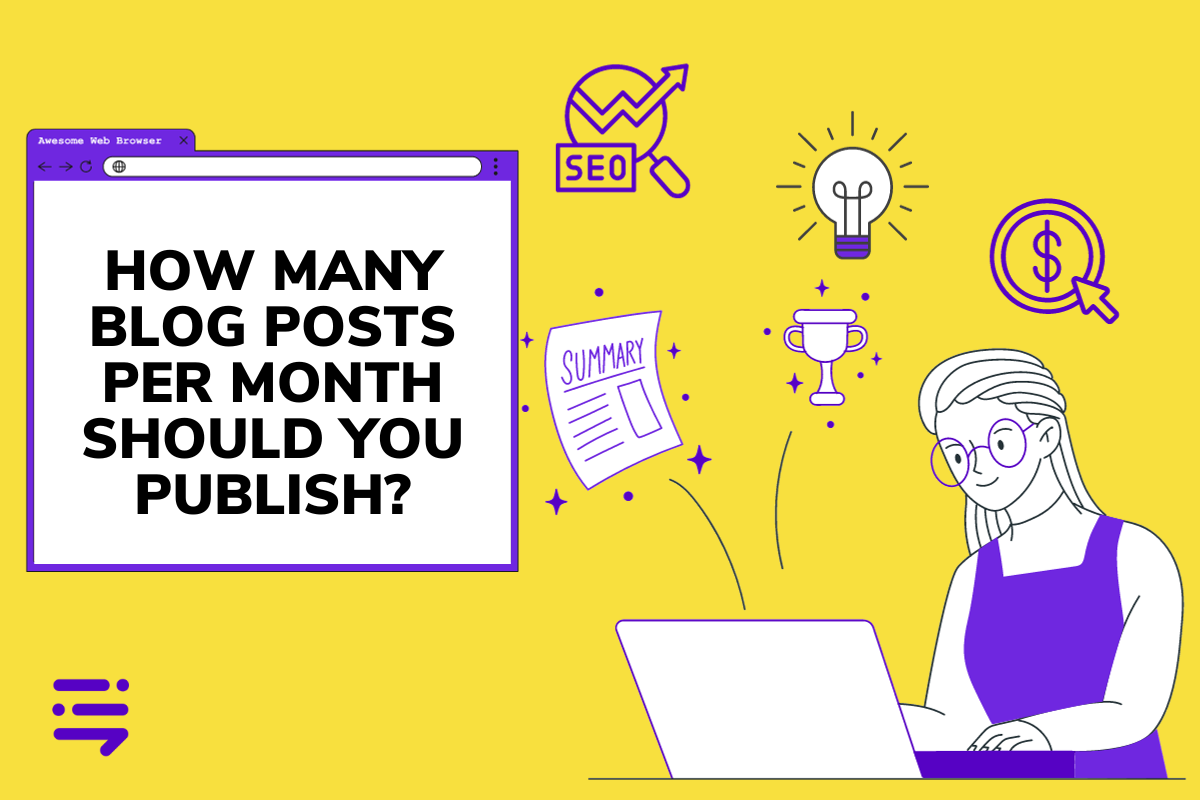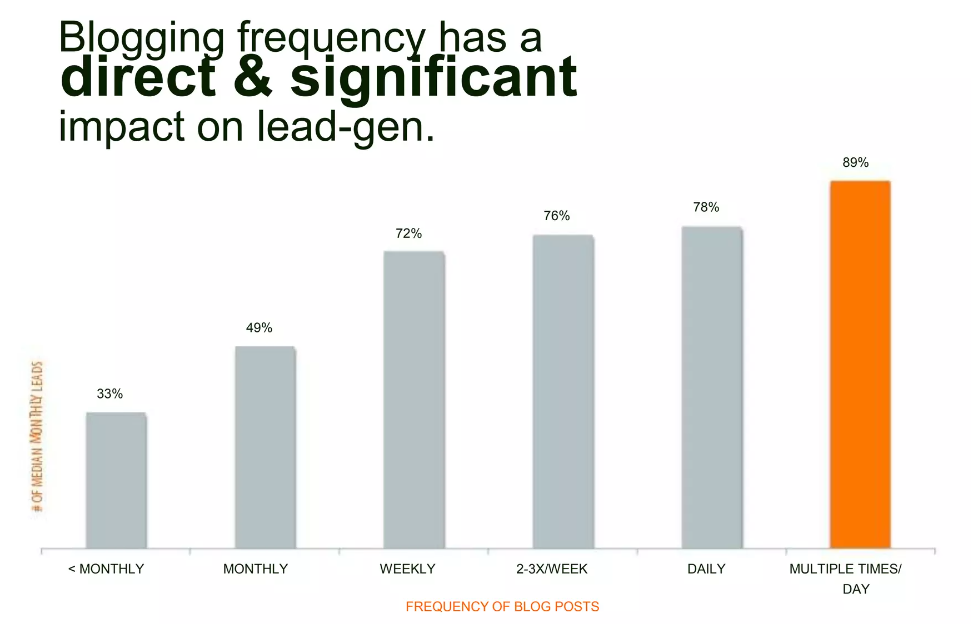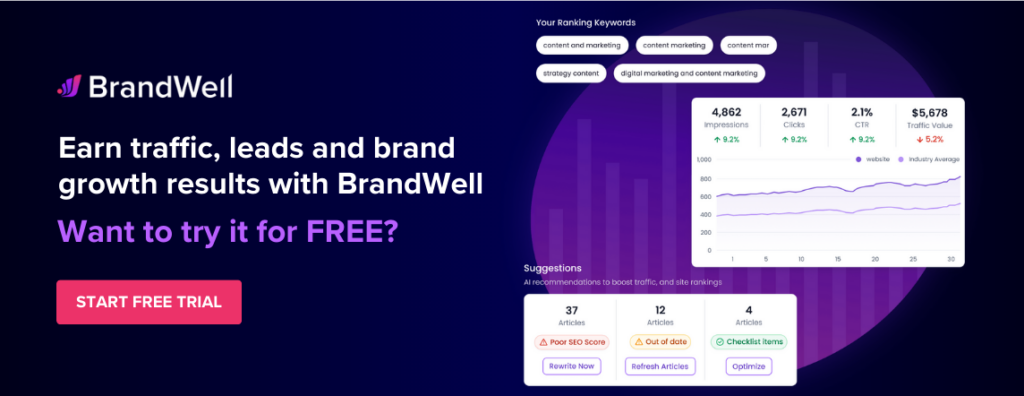Discover top guides, trends, tips and expertise from AIO Writers
How Many Blog Posts Per Month Should You Publish?
Julia McCoy
Tuesday, 18th Apr 2023
In content marketing, consistency is the key to success.
Most organizations use their blog as the cornerstone of that consistency. Blogs help you attract new clients by sharing content that solves their problems, answers their questions, or entertains them.
For content marketing to work, you should stick to a blogging schedule. But how many blog posts per month should you publish?
- According to the latest research, the ideal blog post frequency for small businesses is 2-4 times per week.
- Bigger companies do it almost daily.
This schedule provides the best content marketing results in terms of both blog traffic and conversions.
In this blog post, we’ll cover how often you should publish content to your blog and why it’s important to have a consistent posting frequency.
Table Of Contents:
- How Many Blog Posts Per Month Should You Publish?
- Maximize Your Blogging Frequency for Maximum Results
- FAQs – How Many Blog Posts Per Month?
- How Many Blog Posts Per Month Should You Upload? There is No One-Size-Fits-All Answer
Blog posts are the most powerful tool to build your online presence and boost organic traffic to your website or blog. When you create content, it helps you establish yourself as an authority in your niche and also gives potential customers a better idea about what services or products you offer.
Moreover, every post published on your site is an opportunity to give your brand more exposure when it gets shared across social media platforms, giving you more visibility and recognition from new audiences.
So how often should you blog?
How Many Blog Posts Per Month Should You Publish?
Blogging is one of the most effective ways of connecting with your audience, but figuring out how often you should post is not so clear-cut.
It’s important to establish a reasonable posting schedule that fits your goals and resources. Posting too frequently can overwhelm your readers while posting less often could make them forget all about you.
When creating a content calendar, think about the type of material you are creating and how much time it requires to craft each post. If you do not have the time, money, and human resources, you could start with one or two well-written posts each week rather than a lot of subpar ones.
You should also consider how often your target audience wants new information from you. Researching industry trends can help here – do most blogs in your space post weekly? Daily? Monthly?
Knowing what other successful bloggers in your niche are doing can give you an idea of what works best for readers in terms of frequency and format.
You may also want to poll current followers on social media about their preferences regarding blog post frequency and length so you know exactly what they like (and don’t like).
Maximize Your Blogging Frequency for Maximum Results
Regular blogging is essential for achieving your online marketing goals. It’s an effective way to drive organic traffic, boost search engine rankings, and build relationships with customers. Establishing a reasonable posting schedule will help ensure that you are consistently creating content that drives engagement and provides value to readers.
Quality should always come first when it comes to blogging — no matter how frequently you do it. A single well-written blog post has more impact than five poorly written ones. Make sure each post is informative, engaging, and contains valuable information for your readers.
To measure the performance of your blog posts, you should constantly monitor your metrics such as page views, bounce rate, and time on page. Read the comments left by readers and respond when needed. By engaging your audience, you can get a better understanding of which topics resonate most with them and adapt your content strategy accordingly.

Image Source: HubSpot
Quality Over Quantity
When it comes to content marketing, quality always trumps quantity. Well-researched and well-written informative posts are more impactful than a stream of rehashed or duplicate content.
Rather than posting more blog articles, focus on creating high-quality pieces that are both useful and engaging. This means taking the time to research topics thoroughly, checking facts, and writing in your reader’s language.
It also means avoiding fluff or filler words that don’t add value to the post. Instead of trying to write long sentences or big words, focus on conveying your message in a clear and concise manner.
Optimize Your Posts
In addition to creating quality posts, make sure you are optimizing them for SEO purposes as well. This includes including relevant keywords throughout the post so they can be easily found by search engines when someone searches for related terms online.
Internal links also help add value since they direct readers to other related articles without having to leave the page. This helps keep people engaged with your website longer, which could lead to higher conversion rates.
Engaging in conversations provides more opportunities for link-building when done correctly. Comment on other blogs to draw attention back towards yours and participate in social media groups where potential customers may be discussing similar topics.
Monitor Your Progress
Measuring the success of your blog posts is key to determining which material appeals to readers and which ones fall flat. By monitoring the performance of your content, you can refine your content strategy, adjust tactics as needed, and stay on top of changes in search engine algorithms.
Start by setting up a tracking system for each post so you can see its page views, time on page, comments, and shares. Most blog hosting platforms offer a range of tools that allow you to gain in-depth insights into how readers interact with each post.
Once your tracking system is in place, observe any patterns that emerge over a certain period. If some topics consistently draw more interest than others, then consider creating more content around those ideas. On the other hand, topics that don’t seem to click with readers can be rewritten with new angles or approaches.
Performing regular content audits and ensuring newly published content is optimized from the get-go are top priorities for any SEO expert. This includes optimizing both on-page and off-page elements to make your blog posts rank high in search results.
Track all changes and continue modifying your content creation strategy until you meet your desired outcome.
Adapt as Needed
Look at the data from each post and analyze what worked well and what did not. Analyze page impressions, click-throughs, bounce rate, and conversions, and take note of any patterns that emerge. These insights will help inform how you adjust your posting schedule going forward.
It’s worth noting that some level of experimentation should be expected when determining the right blog posting frequency. Not every piece will resonate with everyone – even what seems to be ‘evergreen’ topics. Therefore, don’t get discouraged if some of your posts do not do well. Instead, use this opportunity as another data point towards understanding who exactly makes up your core reader base.
Try different schedules and see which ones yield better results. If you normally post once a week but feel like it isn’t getting enough traction, try posting twice a week and compare how they perform against each other. You may also want to experiment with different times and days when publishing new posts. Some audiences may prefer to read on weekday mornings while others might respond better late at night or on weekends.
Document any modifications you make for future reference. Maintaining these records will enable you to gauge the impact of the changes you make and help you make better decisions for upcoming postings.
Embrace Automation
Are you struggling with coming up with ideas for new posts? Not enough time to write them all out but don’t want to reduce your frequency either?
You don’t have to sacrifice one for the other. Blogging automation makes it possible to stick to a full content schedule while maintaining the standard of quality your blog has been known for.
Whether you intend to publish 10 posts a day or 100 posts a week, you can make it happen with a trusty tool like BrandWell.
FAQs – How Many Blog Posts Per Month?
How many posts should I post on my blog?
The ideal blog post schedule for small businesses is 2-4 times per week. This is the optimal blog post frequency to maintain visibility and relevancy on search engine rankings, as well as foster relationships with readers.
Ultimately, the frequency of posts will depend on your particular industry. But no matter what schedule you choose, stick to it.
How many articles do successful blogs have?
Successful blogs typically have multiple articles that are regularly updated. Maintaining regular updates of multiple posts is necessary to keep the blog current and draw in readers, as well as enhance its search engine rankings.
The importance of producing quality material surpasses that of quantity, hence, it is essential to focus on crafting interesting and informative pieces rather than meeting your quota.
What is the ideal blog article size?
The ideal blog article size varies depending on the purpose and goals of the post. Generally, blog articles are 500 to 1,500 words long.
Longer posts in the 2,000-word range are better for SEO purposes as they provide more opportunities to include relevant keywords and phrases. Shorter posts can be used when trying to convey a single message — like snippets.
How Many Blog Posts Per Month Should You Upload? There is No One-Size-Fits-All Answer
There is no one-size-fits-all solution when it comes to how many articles should you upload to your blog. It all depends on what you wish to accomplish with your blog. You may need to experiment to find out which posting frequency works best for your particular situation.
With careful planning, you’ll be able to figure out an optimal publishing schedule that maximizes your blogging efforts.
Ready to scale your content? With a powerful brand growth platform like BrandWell, you can publish hundreds of blog posts every month at less cost and with minimal human intervention!

UNLOCK YOUR POTENTIAL
Long Headline that highlights Value Proposition of Lead Magnet
Grab a front row seat to our video masterclasses, interviews, case studies, tutorials, and guides.



